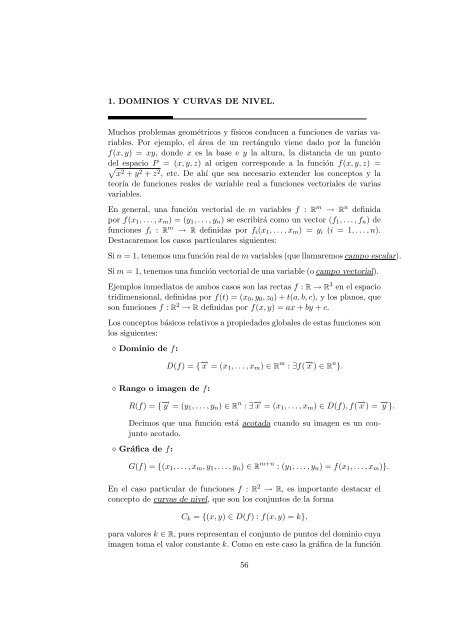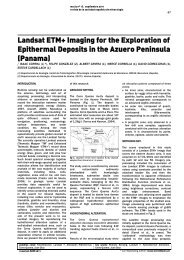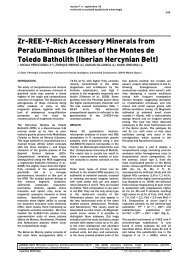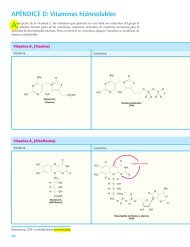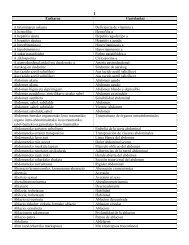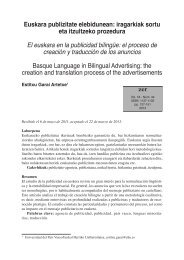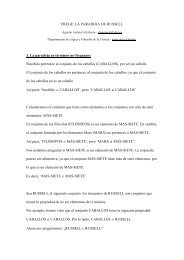Continuidad de funciones de varias variables.
Continuidad de funciones de varias variables.
Continuidad de funciones de varias variables.
You also want an ePaper? Increase the reach of your titles
YUMPU automatically turns print PDFs into web optimized ePapers that Google loves.
1. DOMINIOS Y CURVAS DE NIVEL.<br />
Muchos problemas geométricos y físicos conducen a <strong>funciones</strong> <strong>de</strong> <strong>varias</strong> <strong>variables</strong>.<br />
Por ejemplo, el área <strong>de</strong> un rectángulo viene dado por la función<br />
f(x, y) = xy, don<strong>de</strong> x es la base e y la altura, la distancia <strong>de</strong> un punto<br />
<strong>de</strong>l espacio P = (x, y, z) al origen correspon<strong>de</strong> a la función f(x, y, z) =<br />
x 2 + y 2 + z 2 , etc. De ahí que sea necesario exten<strong>de</strong>r los conceptos y la<br />
teoría <strong>de</strong> <strong>funciones</strong> reales <strong>de</strong> variable real a <strong>funciones</strong> vectoriales <strong>de</strong> <strong>varias</strong><br />
<strong>variables</strong>.<br />
En general, una función vectorial <strong>de</strong> m <strong>variables</strong> f : R m → R n <strong>de</strong>finida<br />
por f(x1, . . . , xm) = (y1, . . . , yn) se escribirá como un vector (f1, . . . , fn) <strong>de</strong><br />
<strong>funciones</strong> fi : R m → R <strong>de</strong>finidas por fi(x1, . . . , xm) = yi (i = 1, . . . , n).<br />
Destacaremos los casos particulares siguientes:<br />
Si n = 1, tenemos una función real <strong>de</strong> m <strong>variables</strong> (que llamaremos campo escalar).<br />
Si m = 1, tenemos una función vectorial <strong>de</strong> una variable (o campo vectorial).<br />
Ejemplos inmediatos <strong>de</strong> ambos casos son las rectas f : R → R 3 en el espacio<br />
tridimensional, <strong>de</strong>finidas por f(t) = (x0, y0, z0) + t(a, b, c), y los planos, que<br />
son <strong>funciones</strong> f : R 2 → R <strong>de</strong>finidas por f(x, y) = ax + by + c.<br />
Los conceptos básicos relativos a propieda<strong>de</strong>s globales <strong>de</strong> estas <strong>funciones</strong> son<br />
los siguientes:<br />
⋄ Dominio <strong>de</strong> f:<br />
⋄ Rango o imagen <strong>de</strong> f:<br />
D(f) = { −→ x = (x1, . . . , xm) ∈ R m : ∃f( −→ x ) ∈ R n }.<br />
R(f) = { −→ y = (y1, . . . , yn) ∈ R n : ∃ −→ x = (x1, . . . , xm) ∈ D(f), f( −→ x ) = −→ y }.<br />
Decimos que una función está acotada cuando su imagen es un conjunto<br />
acotado.<br />
⋄ Gráfica <strong>de</strong> f:<br />
G(f) = {(x1, . . . , xm, y1, . . . , yn) ∈ R m+n : (y1, . . . , yn) = f(x1, . . . , xm)}.<br />
En el caso particular <strong>de</strong> <strong>funciones</strong> f : R 2 → R, es importante <strong>de</strong>stacar el<br />
concepto <strong>de</strong> curvas <strong>de</strong> nivel, que son los conjuntos <strong>de</strong> la forma<br />
Ck = {(x, y) ∈ D(f) : f(x, y) = k},<br />
para valores k ∈ R, pues representan el conjunto <strong>de</strong> puntos <strong>de</strong>l dominio cuya<br />
imagen toma el valor constante k. Como en este caso la gráfica <strong>de</strong> la función<br />
56


